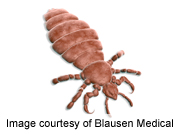- Double Mastectomy May Offer No Survival Benefit to Women With Breast Cancer
- Toxic Lead Found in Cinnamon Product, FDA Says
- Certain Abbott Blood Sugar Monitors May Give Incorrect Readings
- Athletes Can Expect High Ozone, Pollen Counts for Paris Olympics
- Fake Oxycontin Pills Widespread and Potentially Deadly: Report
- Shingles Vaccine Could Lower Dementia Risk
- Your Odds for Accidental Gun Death Rise Greatly in Certain States
- Kids From Poorer Families Less Likely to Survive Cancer
- Tough Workouts Won’t Trigger Cardiac Arrest in Folks With Long QT Syndrome
- At-Home Colon Cancer Test Can Save Lives
Insecticide-Laced Underwear No Match for Lice


Insecticide-treated underwear won’t wipe out lice infestations in homeless shelters, according to a new study.
The strategy initially showed some success, but the lice soon developed resistance to the chemical, the researchers said.
Body lice can spread through direct contact and shared clothing and bedding, and the problem is worsened by overcrowded conditions.
The study, which was published online Dec. 4 in the journal JAMA Dermatology, examined the impact of giving homeless people underwear treated with the insecticide permethrin. Forty participants were given new underwear treated with the insecticide and 33 others received untreated underwear. They were checked 14 and 45 days later.
On day 14, the researchers found that 11 of the 40 people given treated underwear were free of body lice, compared with three of the 33 who received untreated underwear. This difference, however, was no longer evident at day 45, and the body lice showed increasing resistance to the insecticide.
“This trial clearly demonstrates that the use of [insecticide-treated] underwear had the consequence of increasing the percentage of permethrin-resistant body lice in sheltered homeless people,” said study leader Samir Benkouiten, of Aix Marseille University, in France. “These findings lead us to recommend avoiding the use of permethrin to treat body-lice infestations, although implementing new strategies is crucial.”
More information
The U.S. Centers for Disease Control and Prevention has more about body lice.
Source: HealthDay
Copyright © 2024 HealthDay. All rights reserved.










